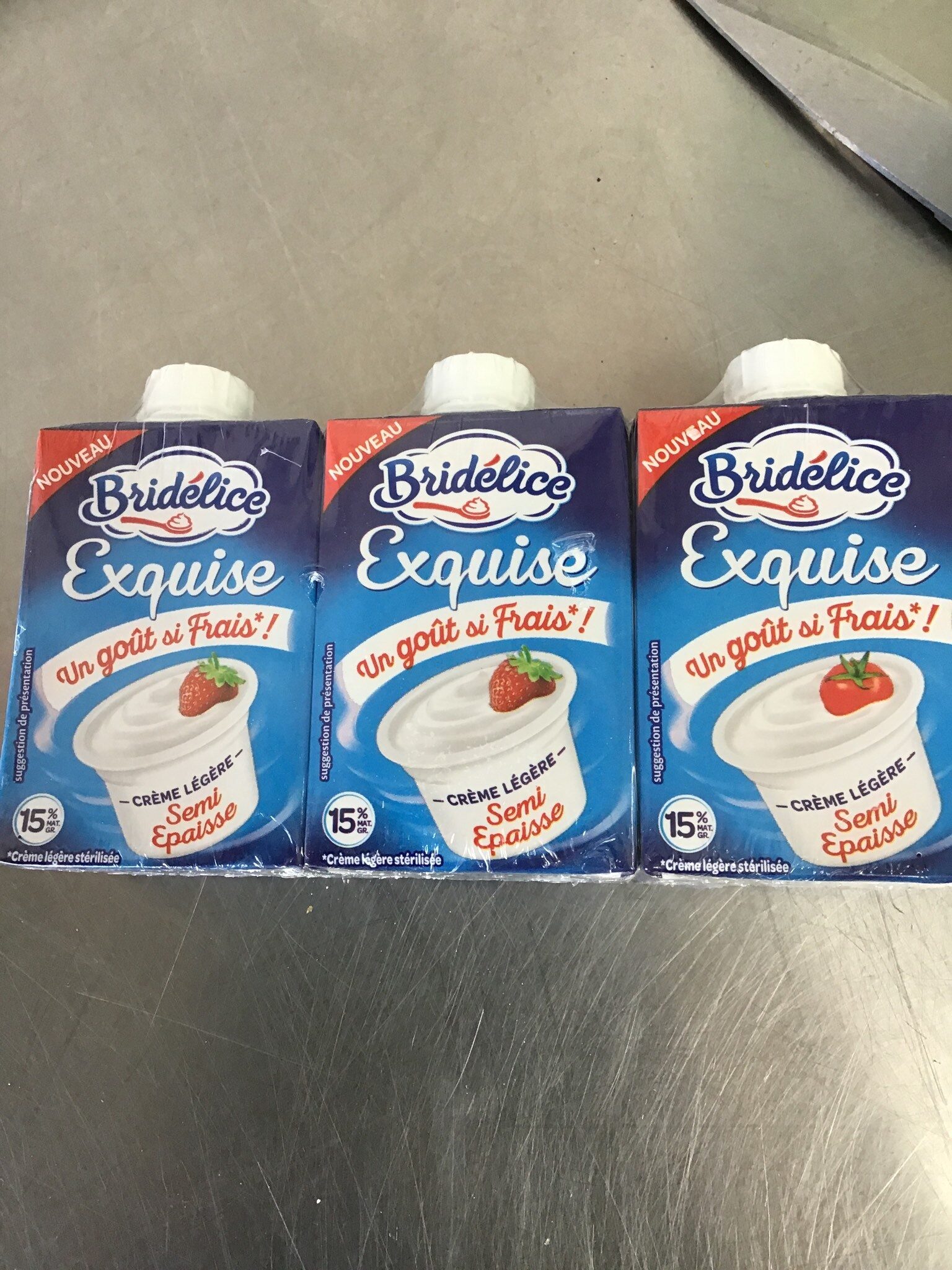Help us make food transparency the norm!
As a non-profit organization, we depend on your donations to continue informing consumers around the world about what they eat.
The food revolution starts with you!
Exquise semi-épaisse 15% Mat.Gr - Bridélice - 20cl x 3
Exquise semi-épaisse 15% Mat.Gr - Bridélice - 20cl x 3
Barcode: 3155250369944 (EAN / EAN-13)
Common name: crème légère stérilisée
Quantity: 20cl x 3
Packaging: fr:Bouchon en plastique, fr:Brique en carton, fr:Film plastique
Brands: Bridélice
Categories: Dairies, Creams, Unfermented creams, fr:Crèmes légères, fr:Crème légère semi-épaisse
Origin of ingredients: France
Traceability code: FR 35.131.001 CE - Hermitage (Ille-et-Vilaine, France), FSC-C014047
Link to the product page on the official site of the producer: https://www.bridelice.fr/nos-produits/cr...
Stores: Carrefour market, carrefour.fr
Countries where sold: France
Matching with your preferences
Health
Ingredients
-
9 ingredients
: Crème légère (97%) (lait) (origine France), amidon de maïs modifié, stabilisants : pectine, cellulose, gomme de cellulose, émulsifiants: E471, E472e.Allergens: Milk
Food processing
-
Ultra processed foods
Elements that indicate the product is in the 4 - Ultra processed food and drink products group:
- Additive: E440 - Pectins
- Additive: E460 - Cellulose
- Additive: E466 - Sodium carboxy methyl cellulose
- Additive: E471 - Mono- and diglycerides of fatty acids
- Additive: E472e - Mono- and diacetyltartaric acid esters of mono- and diglycerides of fatty acids
- Ingredient: Emulsifier
Food products are classified into 4 groups according to their degree of processing:
- Unprocessed or minimally processed foods
- Processed culinary ingredients
- Processed foods
- Ultra processed foods
The determination of the group is based on the category of the product and on the ingredients it contains.
Additives
-
E440 - Pectins
Pectins (E440) are natural carbohydrates, predominantly found in fruits, that act as gelling agents in the food industry, creating the desirable jelly-like texture in jams, jellies, and marmalades.
Pectins stabilize and thicken various food products, such as desserts, confectioneries, and beverages, ensuring a uniform consistency and quality.
Recognized as safe by various health authorities, pectins have been widely used without notable adverse effects when consumed in typical dietary amounts.
-
E460 - Cellulose
Cellulose: Cellulose is an organic compound with the formula -C6H10O5-n, a polysaccharide consisting of a linear chain of several hundred to many thousands of β-1→4- linked D-glucose units. Cellulose is an important structural component of the primary cell wall of green plants, many forms of algae and the oomycetes. Some species of bacteria secrete it to form biofilms. Cellulose is the most abundant organic polymer on Earth. The cellulose content of cotton fiber is 90%, that of wood is 40–50%, and that of dried hemp is approximately 57%.Cellulose is mainly used to produce paperboard and paper. Smaller quantities are converted into a wide variety of derivative products such as cellophane and rayon. Conversion of cellulose from energy crops into biofuels such as cellulosic ethanol is under development as a renewable fuel source. Cellulose for industrial use is mainly obtained from wood pulp and cotton.Some animals, particularly ruminants and termites, can digest cellulose with the help of symbiotic micro-organisms that live in their guts, such as Trichonympha. In human nutrition, cellulose is a non-digestible constituent of insoluble dietary fiber, acting as a hydrophilic bulking agent for feces and potentially aiding in defecation.Source: Wikipedia
-
E466 - Sodium carboxy methyl cellulose
Carboxymethyl cellulose: Carboxymethyl cellulose -CMC- or cellulose gum or tylose powder is a cellulose derivative with carboxymethyl groups --CH2-COOH- bound to some of the hydroxyl groups of the glucopyranose monomers that make up the cellulose backbone. It is often used as its sodium salt, sodium carboxymethyl cellulose.Source: Wikipedia
-
E471 - Mono- and diglycerides of fatty acids
Mono- and diglycerides of fatty acids (E471), are food additives commonly used as emulsifiers in various processed foods.
These compounds consist of glycerol molecules linked to one or two fatty acid chains, which help stabilize and blend water and oil-based ingredients. E471 enhances the texture and shelf life of products like margarine, baked goods, and ice cream, ensuring a smooth and consistent texture.
It is generally considered safe for consumption within established regulatory limits.
Ingredients analysis
-
May contain palm oil
Ingredients that may contain palm oil: E471, E472e
-
Non-vegan
Non-vegan ingredients: Light cream
-
Maybe vegetarian
Ingredients that may not be vegetarian: E471, E472e
-
Details of the analysis of the ingredients
: Crème légère 97%, amidon de maïs modifié, stabilisants (pectine), cellulose, gomme de cellulose, émulsifiants (e471), e472e- Crème légère -> en:light-cream - vegan: no - vegetarian: yes - ciqual_food_code: 19402 - percent_min: 97 - percent: 97 - percent_max: 97
- amidon de maïs modifié -> en:modified-corn-starch - vegan: yes - vegetarian: yes - ciqual_food_code: 9510 - percent_min: 0.5 - percent_max: 3
- stabilisants -> en:stabiliser - percent_min: 0 - percent_max: 2.5
- pectine -> en:e440a - vegan: yes - vegetarian: yes - percent_min: 0 - percent_max: 2.5
- cellulose -> en:e460 - vegan: yes - vegetarian: yes - percent_min: 0 - percent_max: 1.25
- gomme de cellulose -> en:e466 - vegan: yes - vegetarian: yes - percent_min: 0 - percent_max: 0.833333333333333
- émulsifiants -> en:emulsifier - percent_min: 0 - percent_max: 0.625
- e471 -> en:e471 - vegan: maybe - vegetarian: maybe - from_palm_oil: maybe - percent_min: 0 - percent_max: 0.625
- e472e -> en:e472e - vegan: maybe - vegetarian: maybe - from_palm_oil: maybe - percent_min: 0 - percent_max: 0.5
Nutrition
-
Poor nutritional quality
⚠ ️Warning: the amount of fiber is not specified, their possible positive contribution to the grade could not be taken into account.⚠ ️Warning: the amount of fruits, vegetables and nuts is not specified on the label, it was estimated from the list of ingredients: 0This product is not considered a beverage for the calculation of the Nutri-Score.
Positive points: 0
- Proteins: 1 / 5 (value: 2.1, rounded value: 2.1)
- Fiber: 0 / 5 (value: 0, rounded value: 0)
- Fruits, vegetables, nuts, and colza/walnut/olive oils: 0 / 5 (value: 0, rounded value: 0)
Negative points: 12
- Energy: 2 / 10 (value: 703, rounded value: 703)
- Sugars: 1 / 10 (value: 5.8, rounded value: 5.8)
- Saturated fat: 9 / 10 (value: 10, rounded value: 10)
- Sodium: 0 / 10 (value: 52, rounded value: 52)
The points for proteins are not counted because the negative points are greater or equal to 11.
Nutritional score: (12 - 0)
Nutri-Score:
-
Nutrient levels
-
Fat in moderate quantity (15%)
What you need to know- A high consumption of fat, especially saturated fats, can raise cholesterol, which increases the risk of heart diseases.
Recommendation: Limit the consumption of fat and saturated fat- Choose products with lower fat and saturated fat content.
-
Saturated fat in high quantity (10%)
What you need to know- A high consumption of fat, especially saturated fats, can raise cholesterol, which increases the risk of heart diseases.
Recommendation: Limit the consumption of fat and saturated fat- Choose products with lower fat and saturated fat content.
-
Sugars in moderate quantity (5.8%)
What you need to know- A high consumption of sugar can cause weight gain and tooth decay. It also augments the risk of type 2 diabetes and cardio-vascular diseases.
Recommendation: Limit the consumption of sugar and sugary drinks- Sugary drinks (such as sodas, fruit beverages, and fruit juices and nectars) should be limited as much as possible (no more than 1 glass a day).
- Choose products with lower sugar content and reduce the consumption of products with added sugars.
-
Salt in low quantity (0.13%)
What you need to know- A high consumption of salt (or sodium) can cause raised blood pressure, which can increase the risk of heart disease and stroke.
- Many people who have high blood pressure do not know it, as there are often no symptoms.
- Most people consume too much salt (on average 9 to 12 grams per day), around twice the recommended maximum level of intake.
Recommendation: Limit the consumption of salt and salted food- Reduce the quantity of salt used when cooking, and don't salt again at the table.
- Limit the consumption of salty snacks and choose products with lower salt content.
-
-
Nutrition facts
Nutrition facts As sold
for 100 g / 100 mlCompared to: fr:Crèmes légères Energy 703 kj
(168 kcal)- Fat 15 g - Saturated fat 10 g - Carbohydrates 6.1 g +14% Sugars 5.8 g +48% Fiber ? Proteins 2.1 g -24% Salt 0.13 g +19% Alcohol 0 % vol Fruits‚ vegetables‚ nuts and rapeseed‚ walnut and olive oils (estimate from ingredients list analysis) 0 %
Environment
-
Eco-Score A - Very low environmental impact
⚠ ️Select a country in order to include the full impact of transportation.The Eco-Score is an experimental score that summarizes the environmental impacts of food products.→ The Eco-Score was initially developped for France and it is being extended to other European countries. The Eco-Score formula is subject to change as it is regularly improved to make it more precise and better suited to each country.Life cycle analysis
-
Average impact of products of the same category: A (Score: 84/100)
Category: Liquid cream, light, 15-20% fat, UHT
Category: Liquid cream, light, 15-20% fat, UHT
- PEF environmental score: 0.24 (the lower the score, the lower the impact)
- including impact on climate change: 2.45 kg CO2 eq/kg of product
Stage Impact Agriculture
77.3 %Processing
11.3 %Packaging
6.1 %Transportation
3.3 %Distribution
1.9 %Consumption
0.0 %
Bonuses and maluses
-
Origins of ingredients with a medium impact
Bonus: +4
Environmental policy: +4
Transportation: 0
Origin of the product and/or its ingredients % of ingredients Impact France 100 %Medium
-
Packaging with a low impact
Malus: -3
Shape Material Recycling Impact 1 Film Plastic Discard High 3 Brick Cardboard Recycle Low 3 Bottle cap Plastic Recycle High
Eco-Score for this product
-
Impact for this product: A (Score: 85/100)
Product: Exquise semi-épaisse 15% Mat.Gr - Bridélice - 20cl x 3
Life cycle analysis score: 84
Sum of bonuses and maluses: +1
Final score: 85/100
-
Carbon footprint
-
Equal to driving 1.3 km in a petrol car
245 g CO² per 100g of product
The carbon emission figure comes from ADEME's Agribalyse database, for the category: Liquid cream, light, 15-20% fat, UHT (Source: ADEME Agribalyse Database)
Stage Impact Agriculture
82.5 %Processing
5.3 %Packaging
7.4 %Transportation
4.2 %Distribution
0.6 %Consumption
0.0 %
Packaging
-
Packaging with a low impact
-
Packaging parts
3 x Brick (Cardboard)
3 x Bottle cap (Plastic)
1 x Film (Plastic)
-
Packaging materials
Material % Packaging weight Packaging weight per 100 g of product Paper or cardboard Plastic Total
-
Transportation
-
Origins of ingredients
Origins of ingredients with a medium impact
Origin of the product and/or its ingredients % of ingredients Impact France 100 %Medium
Report a problem
-
Incomplete or incorrect information?
Category, labels, ingredients, allergens, nutritional information, photos etc.
If the information does not match the information on the packaging, please complete or correct it. Open Food Facts is a collaborative database, and every contribution is useful for all.
Data sources
Product added on by kiliweb
Last edit of product page on by didierg.
Product page also edited by date-limite-app, driveoff, ecoscore-impact-estimator, helened, openfoodfacts-contributors, packbot, pauline30, roboto-app, yuka.FasTDsGKGcYHPMWI96Um4mXjJenfB_IBJ0VRog, yuka.ZWY1WUs2UW9nK2dHbmZFMDVpblMzWU4xOTdhT0RHT2VPdlE2SVE9PQ, yuka.sY2b0xO6T85zoF3NwEKvlmJXeIH_uBDoPjPkq2uI9NOoH7DlTtpPsqH9Fas.













